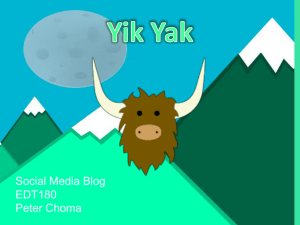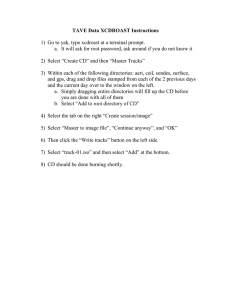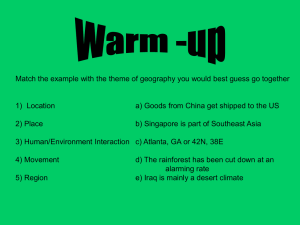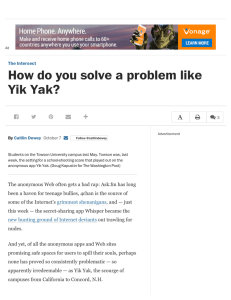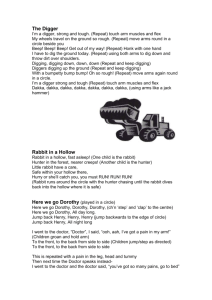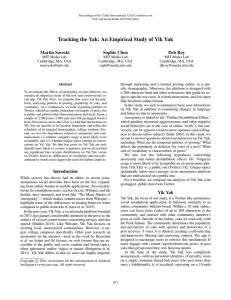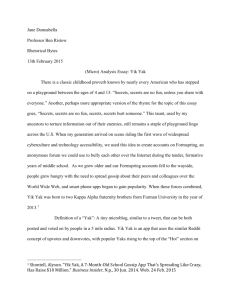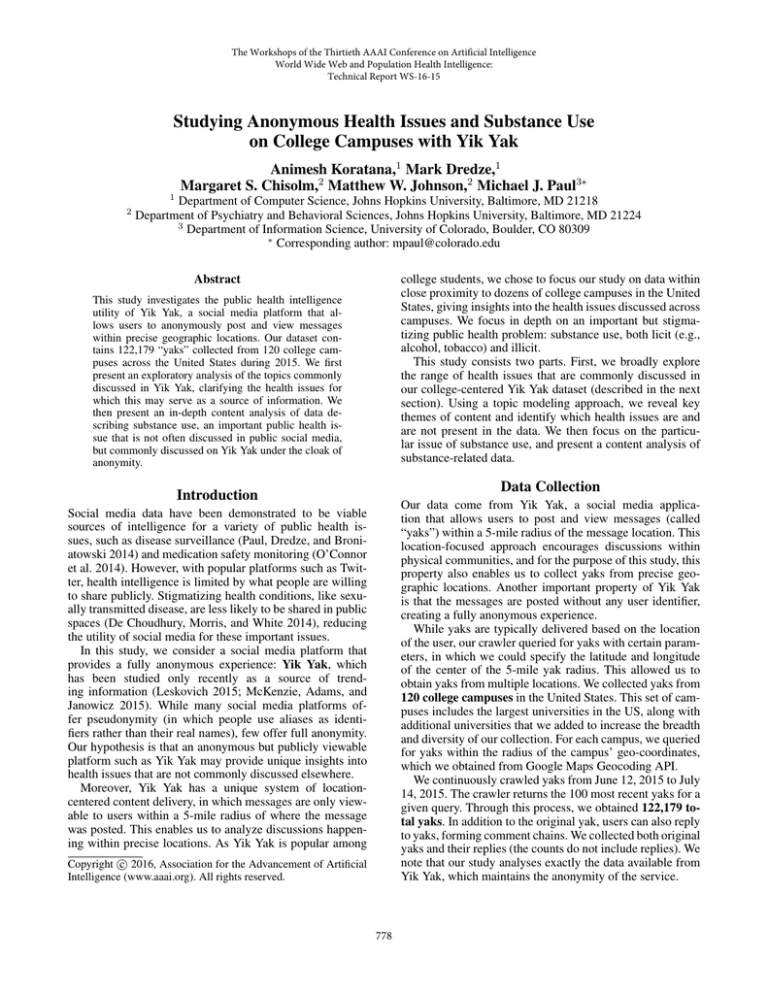
The Workshops of the Thirtieth AAAI Conference on Artificial Intelligence
World Wide Web and Population Health Intelligence:
Technical Report WS-16-15
Studying Anonymous Health Issues and Substance Use
on College Campuses with Yik Yak
Animesh Koratana,1 Mark Dredze,1
Margaret S. Chisolm,2 Matthew W. Johnson,2 Michael J. Paul3∗
1
2
Department of Computer Science, Johns Hopkins University, Baltimore, MD 21218
Department of Psychiatry and Behavioral Sciences, Johns Hopkins University, Baltimore, MD 21224
3
Department of Information Science, University of Colorado, Boulder, CO 80309
∗
Corresponding author: mpaul@colorado.edu
Abstract
college students, we chose to focus our study on data within
close proximity to dozens of college campuses in the United
States, giving insights into the health issues discussed across
campuses. We focus in depth on an important but stigmatizing public health problem: substance use, both licit (e.g.,
alcohol, tobacco) and illicit.
This study consists two parts. First, we broadly explore
the range of health issues that are commonly discussed in
our college-centered Yik Yak dataset (described in the next
section). Using a topic modeling approach, we reveal key
themes of content and identify which health issues are and
are not present in the data. We then focus on the particular issue of substance use, and present a content analysis of
substance-related data.
This study investigates the public health intelligence
utility of Yik Yak, a social media platform that allows users to anonymously post and view messages
within precise geographic locations. Our dataset contains 122,179 “yaks” collected from 120 college campuses across the United States during 2015. We first
present an exploratory analysis of the topics commonly
discussed in Yik Yak, clarifying the health issues for
which this may serve as a source of information. We
then present an in-depth content analysis of data describing substance use, an important public health issue that is not often discussed in public social media,
but commonly discussed on Yik Yak under the cloak of
anonymity.
Data Collection
Introduction
Our data come from Yik Yak, a social media application that allows users to post and view messages (called
“yaks”) within a 5-mile radius of the message location. This
location-focused approach encourages discussions within
physical communities, and for the purpose of this study, this
property also enables us to collect yaks from precise geographic locations. Another important property of Yik Yak
is that the messages are posted without any user identifier,
creating a fully anonymous experience.
While yaks are typically delivered based on the location
of the user, our crawler queried for yaks with certain parameters, in which we could specify the latitude and longitude
of the center of the 5-mile yak radius. This allowed us to
obtain yaks from multiple locations. We collected yaks from
120 college campuses in the United States. This set of campuses includes the largest universities in the US, along with
additional universities that we added to increase the breadth
and diversity of our collection. For each campus, we queried
for yaks within the radius of the campus’ geo-coordinates,
which we obtained from Google Maps Geocoding API.
We continuously crawled yaks from June 12, 2015 to July
14, 2015. The crawler returns the 100 most recent yaks for a
given query. Through this process, we obtained 122,179 total yaks. In addition to the original yak, users can also reply
to yaks, forming comment chains. We collected both original
yaks and their replies (the counts do not include replies). We
note that our study analyses exactly the data available from
Yik Yak, which maintains the anonymity of the service.
Social media data have been demonstrated to be viable
sources of intelligence for a variety of public health issues, such as disease surveillance (Paul, Dredze, and Broniatowski 2014) and medication safety monitoring (O’Connor
et al. 2014). However, with popular platforms such as Twitter, health intelligence is limited by what people are willing
to share publicly. Stigmatizing health conditions, like sexually transmitted disease, are less likely to be shared in public
spaces (De Choudhury, Morris, and White 2014), reducing
the utility of social media for these important issues.
In this study, we consider a social media platform that
provides a fully anonymous experience: Yik Yak, which
has been studied only recently as a source of trending information (Leskovich 2015; McKenzie, Adams, and
Janowicz 2015). While many social media platforms offer pseudonymity (in which people use aliases as identifiers rather than their real names), few offer full anonymity.
Our hypothesis is that an anonymous but publicly viewable
platform such as Yik Yak may provide unique insights into
health issues that are not commonly discussed elsewhere.
Moreover, Yik Yak has a unique system of locationcentered content delivery, in which messages are only viewable to users within a 5-mile radius of where the message
was posted. This enables us to analyze discussions happening within precise locations. As Yik Yak is popular among
c 2016, Association for the Advancement of Artificial
Copyright Intelligence (www.aaai.org). All rights reserved.
778
Health Topics
Topic 9
“ SLEEP ”
sleep
day
bed
night
im
work
go
morning
home
time
Topic 16
“ HYGIENE ”
poop
shit
toilet
bathroom
ass
like
shower
eat
paper
pee
Topic 26
“ SEX ”
sex
like
girl
get
girls
guys
guy
time
want
feel
Topic 27
“ DRUGS ”
weed
smoke
drugs
smoking
drug
doctor
high
take
anxiety
got
Topic 13
“ SOCIAL”
friends
friend
people
best
im
like
feel
new
make
lonely
Topic 17
“ FAMILY ”
mom
dad
parents
family
kids
baby
child
sister
kid
brother
Topic 18
Topic 34
“ SEX ”
dick
suck
mouth
kiss
tip
head
give
pussy
blow
want
Topic 36
“ FOOD ”
eat
food
pizza
good
eating
cheese
chicken
chipotle
like
want
Topic 39
“ DRINK ”
drink
drunk
coffee
beer
drinking
water
alcohol
wine
milk
starbucks
Topic 40
“ WEIGHT ”
fat
weight
gym
eat
body
lose
healthy
eating
im
workout
Topic 48
“ HYGIENE ”
smell
use
like
shower
water
teeth
wash
skin
hair
face
Topic 23
“ HOUSING ”
room
live
roommate
house
apartment
living
roommates
home
place
move
Topic 38
“ RELIGION ”
god
church
religion
jesus
marriage
believe
religious
bible
christian
gay
Topic 42
“ JOBS ”
money
job
get
pay
work
buy
much
make
need
would
Topic 44
“ SCHOOL”
class
major
classes
summer
school
take
taking
study
hard
professor
Other Topics
Topic 1
“ PARTYING ”
go
party
tonight
going
good
bar
fun
place
night
bars
“ SEXUALITY ”
gay
straight
im
guy
guys
girl
bi
want
lesbian
dude
Topic 19
“ RACE ”
white
black
people
racist
race
asian
im
racism
privilege
color
Table 1: Example topics learned by Latent Dirichlet Allocation on our Yik Yak corpus. These examples include the top 10
words of all 9 health topics and a sample of 9 other topics, with manually assigned topic labels.
Health Topics in Yik Yak
The health topics we identified covered the following
public health problems: sleep, personal hygiene (2 topics),
sexual activity (2 topics), substance use, food consumption, beverage consumption (including alcohol), and body
weight/image. While not all of these topics are explicitly
about health, some of them would be of interest in certain
areas of public health. For example, the topic about food
consumption would be relevant for the study of dietary patterns. Other topics not identified as health include recreation,
relationships, and politics. Examples of both health-related
topics and other topics are shown in Table 1. We note with
interest that so many of the topics were relevant to health.
We make two observations about these topics. First, there
is a high proportion of topics on sensitive subjects such as
sex, substance use, and bathroom habits. This supports our
hypothesis that anonymity supports disclosure of such subjects, although the focus on college campuses may also skew
the topic content. Second, there is an absence of health topics that are commonly observed in other social media platforms like Twitter, such as upper respiratory infections and
influenza-like illness. These findings suggest that Yik Yak is
a poor source of general health intelligence, but a potential
source for understanding certain high-stigma issues.
We first explore the content of the dataset using a topic modeling approach to identify prominent themes in the yaks.
Topic models have previously been applied to social media data to understand which health issues are prominently
discussed (Paul and Dredze 2011; 2014; Prier et al. 2011;
Ghosh and Guha 2013; Wang, Paul, and Dredze 2014). The
goal is to characterize the topic content of the corpus so that
we understand the set of public health problems for which
Yik Yak is a potential source of information.
We used Latent Dirichlet Allocation (LDA) (Blei, Ng,
and Jordan 2003), a widely-used probabilistic topic model in
which each text document has a distribution over latent “topics” and each topic has a distribution over words. By inferring the parameters of the model, we can learn which words
cluster together as topics, and which topics are present in
each document. We applied LDA to our corpus using 50
topics, treating each yak concatenated with its replies as a
single document. We examined the top words for each topic
and selected topics which were potentially pertinent to public health. Out of 50 topics, 9 topics were identified as being
potentially relevant to health.1
1
We attempted to identify more health topics by running LDA
on a subset of the corpus that had been filtered for health, following
the approach of Paul and Dredze (2014) which filters messages for
health-related terms. However, this approach substantially reduced
the amount of data without resulting in a broader set of health topics upon inspection. It also appears that there is simply not a high
diversity of health issues commonly discussed in Yik Yak.
Substance Use Disclosure in Yaks
We now turn our attention to analyzing patterns in substance
use, as disclosed through yaks. This is a public health issue for which social media holds promise, because traditional methods for monitoring substance use are often years
779
Code
Use, neutral
Use, positive
Substance
Alcohol
Marijuana
Use, negative
Solicitation
Social group
Addiction
Info-seeking
LSD
Alcohol
Marijuana
Tobacco
Marijuana
Yak
Who else is already several beers deep?
I love smoking bud. It’s the rare time when I’m not physically or emotionally hurting. I’ll take
a hit, forget why I’m depressed. I can actually smile again.
Did acid and think it might’ve messed with me. Would not recommend it for the feeble minded
I would like someone to buy me booze
Anyone want to smoke? I got the weed and now I want some company
It’s a funny realization when you realize that you’ll just never quit smoking cigarettes
What is it like to be high? I’ve never smoked pot.
Table 2: Representative examples (paraphrased to preserve privacy) of yaks coded with various categories.
Alcohol Tobacco Marijuana
Code Distribution
Use
50.6%
30.0%
44.4%
Solicitation
17.3%
3.3%
23.1%
Social groups
17.3%
23.3%
14.5%
Addiction
6.2%
26.7%
2.6%
Info-seeking
8.6%
16.7%
15.4%
N
81
30
117
Use: Positive or Negative Experiences
Positive
4.9%
0.0%
7.7%
Negative
14.6%
0.0%
5.8%
Neutral
80.5%
100.0%
86.5%
N
41
9
52
out of date (Dunn et al. 2011). However, substance use is
less commonly discussed in popular social media, especially illegal drugs, though there are exceptions (CavazosRehg et al. 2015). Previous work has primarily focused
on online forums for substance users (Deluca et al. 2012;
Paul and Dredze 2013), but forums do not provide precise
location metadata and thus cannot focus on college locations as we do here. Moreover, due to lack of full anonymity
(among other reasons), most forums prohibit the discussion
of buying and selling of illicit drugs, which is an issue we
are able to examine in this study.
While the topic model results provide an overview of general content, the results are not granular enough to isolate
specific substances—for instance, “starbucks” and “alcohol”
appear in the same topic. For more accurate content analysis, we used a manual coding approach. To find yaks relevant to substances, we filtered our corpus using a large set
of substance-related keywords, and then further reduced the
size of this collection by manually reading through all yaks
and noting those related to substance use. For this study, substances include alcohol and tobacco as well as marijuana and
other illicit drugs. This process resulted in 2,047 substancerelated yaks. Two annotators (one annotator per yak) then
coded a sample of 500 of the substance yaks for categories
of interest (one code per yak):
Other
55.0%
20.0%
5.0%
10.0%
10.0%
20
9.1%
18.2%
72.7%
11
Table 3: The distribution of codes for substance-related
yaks, by substance type. N is the number of annotated yaks
per drug (14 yaks had multiple drugs). Bottom: the distribution of sentiment codes for the subset of yaks labeled as
describing substance use.
Substance Frequencies
The most commonly mentioned substances are marijuana
(117 yaks), alcohol (81 yaks), and tobacco-derived products
(30 yaks, including 2 yaks specifically mentioning electronic
cigarettes). Other substances include Adderall (8 yaks), LSD
(6 yaks), psilocybin (2 yaks), methamphetamine (1 yak),
flakka (1 yak) and sleeping pills (1 yak).
• Substance use: if the user discloses that (s)he has used a
substance, past or present. If so, we also record whether
the user describes the substance use as a positive or negative experience, if either.
• Addiction: if a yak references a substance addiction or an
attempt to discontinue use, past or present.
Polysubstance use An important issue in public health is
which substances are taken in combination. To explore this
property, we counted the number of yaks which mentioned
two or more substances. The most common pairs of substances are alcohol/marijuana (7 yaks), alcohol/tobacco (2
yaks), and marijuana/tobacco (2 yaks), while there were also
mentions of alcohol/Adderall, alcohol/sleeping pills, marijuana/sleeping pills, and marijuana/psilocybin (1 yak each).
• Information-seeking: if the user asks for information
about a substance, such as legal or safety information.
Code Breakdown
For yaks that fit multiple categories, we selected the most
salient code; yaks that fit none of these categories are simply
labeled “Other”. In addition to these categories, we noted
which drug(s) are referenced in the yak, if any.
Of the 500 annotated yaks, 234 yaks matched one of these
categories, which we now summarize. Example yaks are
shown in Table 2, illustrating the various content categories.
The distribution of codes among yaks labeled with different
substance types are shown in Table 3. We observe some variation in the distribution across different types of substances.
Notably, tobacco had a far higher proportion of addictionrelated yaks than other substances. Most of these yaks described attempts to quit smoking, or were celebrating abstinence from smoking (“smoke free, one year later!”). While
• Solicitation: if the user seeks to acquire or provide a substance.
• Social groups: if the user is looking for others with whom
to use a substance with.
780
Despite these challenges, we believe that platforms with
similar properties as Yik Yak, especially full anonymity, can
provide an outlet for the sharing of important information
for understanding population health.
we did not quantify the replies to yaks, we observed they
were often supportive (“stay strong!”).
We noted that the vast majority of solicitation yaks were
for acquisition (e.g., buying) rather than providing (e.g., selling). Compared to the other substances, this type of yak was
extremely rare for tobacco. This is likely because there are
fewer legal barriers among a college-age cohort to obtaining
tobacco (minimum age 18) than alcohol (minimum age 21)
and illegal substances.
We noted a number of people use Yik Yak to find friends
to use substances with (“I don’t like smoking alone”). This
type of yak was less common for the “other” type than for
the three most popular substances, perhaps because the illicit
nature of many other drugs makes this a riskier proposition.
Alcohol had the smallest proportion of informationseeking yaks, perhaps because this is is one of the most
widely used substances among college students and fewer
questions need to be asked. A very broad range of yaks were
coded with this category: opinions on substances, clarifications of law, recommendations for places to use drugs, recommendations for which drug to use, etc. We did not code
the replies to yaks in this analysis, though replies might be
an additional source for analyzing opinions on substances.
References
Bernstein, M. S.; Monroy-Hernández, A.; Harry, D.; André,
P.; Panovich, K.; and Vargas, G. G. 2011. 4chan and /b/:
An analysis of anonymity and ephemerality in a large online
community. In ICWSM.
Blei, D. M.; Ng, A. Y.; and Jordan, M. I. 2003. Latent dirichlet allocation. The Journal of Machine Learning Research
3:993–1022.
Cavazos-Rehg, P. A.; Krauss, M.; Fisher, S. L.; Salyer, P.;
Grucza, R. A.; and Bierut, L. J. 2015. Twitter chatter about
marijuana. J Adolesc Health 56(2):139–145.
Culotta, A.; Kumar, N. R.; and Cutler, J. 2015. Predicting the Demographics of Twitter Users from Website Traffic
Data. In AAAI.
De Choudhury, M.; Morris, M. R.; and White, R. W. 2014.
Seeking and sharing health information online: Comparing
search engines and social media. In CHI, 1365–1376.
Deluca, P.; Davey, Z.; Corazza, O.; Di Furia, L.; Farre, M.;
Flesland, L. H.; and et al. 2012. Identifying emerging
trends in recreational drug use; outcomes from the Psychonaut Web Mapping Project. Prog. Neuropsychopharmacol.
Biol. Psychiatry 39(2):221–226.
Dunn, M.; Bruno, R.; Burns, L.; and Roxburgh, A. 2011. Effectiveness of and challenges faced by surveillance systems.
Drug Testing and Analysis 3(9):635–641.
Ghosh, D. D., and Guha, R. 2013. What are we ‘tweeting’ about obesity? Mapping tweets with Topic Modeling
and Geographic Information System. Cartogr Geogr Inf Sci
40(2):90–102.
Leskovich, W. R. 2015. Yik Yak: a social media sensor. In
SPIE, 9499.
McKenzie, G.; Adams, B.; and Janowicz, K. 2015. Of oxen
and birds: Is Yik Yak a useful new data source in the geosocial zoo or just another Twitter? In ACM SIGSPATIAL International Workshop on Location-Based Social Networks.
O’Connor, K.; Pimpalkhute, P.; Nikfarjam, A.; Ginn, R.;
Smith, K. L.; and Gonzalez, G. 2014. Pharmacovigilance
on Twitter? Mining tweets for adverse drug reactions. AMIA
2014.
Paul, M. J., and Dredze, M. 2011. You are what you Tweet:
Analyzing Twitter for public health. In ICWSM.
Paul, M., and Dredze, M. 2013. Drug extraction from the
web: Summarizing drug experiences with multi-dimensional
topic models. In NAACL.
Paul, M. J., and Dredze, M. 2014. Discovering health
topics in social media using topic models. PLoS ONE
9(8):e103408.
Paul, M. J.; Dredze, M.; and Broniatowski, D. 2014. Twitter
improves influenza forecasting. PLOS Currents Outbreaks.
Sentiment The vast majority of yaks that referenced substance use did not express a positive or negative experience,
but of those that did, the sentiment was usually negative.
Marijuana was an exception, with slightly more positive.
Discussion and Conclusion
We have presented what we believe to be the first study of
Yik Yak as a potential source of public health intelligence,
investigating this question broadly, through exploratory data
analysis, and in depth, for the specific public health issue
of substance use, finding high rates of substance use disclosure. Our analysis illuminated differences between different
substances, such as a high proportion of addiction-related
messages for tobacco, and a high proportion of solicitationrelated messages for marijuana. Our findings suggest that
Yik Yak is a potential source of candid information for
studying substance use or other stigmatizing health issues.
While yaks have properties that make them unique from
other social media, they also pose a number of limitations.
Demographic attributes, which are important for epidemiological research, are unknown due to anonymity. While there
is research on inferring such attributes from text (Rao et al.
2011; Culotta, Kumar, and Cutler 2015; Volkova et al. 2015)
this often requires longer posting histories from users than
isolated messages, yet with Yik Yak, there is generally no
way to know if different messages are posted by the same
person (unless users choose to provide identifiers through
messages (Bernstein et al. 2011)). Similarly, while we targeted college campuses, we do not know which users are
students. Our focus on campuses was intentional, but this
means that it is not clear to what extent our topic and content
analysis generalizes to Yik Yak as a whole. Because yaks are
delivered around specified geographic points, it is a challenge to collect data that is geographically representative.
781
Prier, K. W.; Smith, M. S.; Giraud-Carrier, C.; and Hanson,
C. L. 2011. Identifying health-related topics on Twitter: An
exploration of tobacco-related tweets as a test topic. In SBP,
18–25.
Rao, D.; Paul, M.; Fink, C.; Yarowsky, D.; Oates, T.; and
Coppersmith, G. 2011. Hierarchical Bayesian models for
latent attribute detection in social media. In ICWSM.
Volkova, S.; Bachrach, Y.; Armstrong, M.; and Sharma, V.
2015. Inferring latent user properties from texts published
in social media. In AAAI.
Wang, S.; Paul, M. J.; and Dredze, M. 2014. Exploring
health topics in Chinese social media: An analysis of Sina
Weibo. In AAAI Workshop on the World Wide Web and Public Health Intelligence.
782

